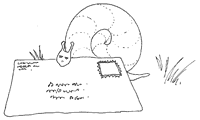STRANGE BUT TRUE- Neither snow nor slime: Some mail really <i>is </i>slow

DRAWING BY DEBORAH DERR McCLINTOCK
Q. Is snail mail ever literally slow as a snail? –B. Franklin
A. Snail mail will cross the North American continent in a few days, averaging maybe 60 mph. Make that overnight mail, and this doubles to 120 mph or so. It would take a snail going .006 mph (.1 inch per second) half a century to make the same journey. However, mail something to your neighbor down the street and next-day delivery will put it there at an average speed of maybe 30 feet per hour– literally the speed of a snail.
Q. It turns out that a baseball outfielder chasing down a long fly ball and a dog catching a tossed Frisbee have a lot in common. Explain. –W. Herzog
A. Both employ the LOT model of retrieving objects in flight, for "linear optical trajectory." Here the player tries to keep the image of the ball at a relatively stable spot on his retina, so it appears to move in a straight line
of sight and constant speed relative to home plate and any background features, says Ivars Peterson in "MathTrek" online.
This is done unconsciously, reducing a complex 3-dimensional problem to a 2-dimensional one. The model helps explain why outfielders navigate an arc-shaped path to the ball rather than make a beeline for the expected landing spot, and why they may vary their pursuit speed. Naturally, long before LOT kicks in, fielding clues come from watching the batter's swing and listening for the sound of the ball hitting the bat– solid sweet smack vs off-center clunk, says Robert Adair in The Physics of Baseball.
As for the dog/catcher, a few Frisbee-tosssing scientists outfitted a canine named Romeo with a miniature video camera, battery pack, and transmitter to track the Frisbee's optical location at 30 frames per second, says Photonics Spectra magazine. The data showed the dog's course closely followed the LOT model, even when the toy was thrown to veer off at a new angle in midflight.
Q. Hospitalized, you overhear the doctor tell your family, "I think we can say about Mr. Smith's condition that
it's all downhill from here." Reason for hope, or should you check to make sure your life insurance is paid up? What's the usage doctor's prognosis? –A. Taylor
A. Ambiguous at best, because "going downhill" is one of those phrases that can go both ways, says Mark Davidson in Right, Wrong and Risky: A Dictionary of Today's American English Usage. Things can be getting increasingly better– you'll be coasting– or increasingly worse– everything is deteriorating. Maybe the doctor's being deliberately vague with your family, or isn't up on the nuances of language. At least he didn't say "It's all uphill from here."
Q. Why might a submarine skipper seek out a colony of "killer" shrimp, such as the snapping shrimp Alpheus heterochaelis or the peacock mantis shrimp Odontodactylus scyllarus? –C. Nemo
A. The snapping shrimp goes after prey by snapping its oversized claw nearby, expelling a jet of water and creating noisy collapsing bubbles (cavitation) that stun or kill the intended meal, says Jearl Walker in The Flying Circus of Physics. The pressure variation here can be so severe it sets off a flash of light– "sonoluminescence." The peacock shrimp also produces sound pulses via cavitation, but the bubbles are due to the snapping motion of the feeding appendage, which rapidly flicks toward prey. The oceans are indeed alive with sound, and in some places so much sound is produced by shrimp that a submarine can avoid sonar detection by hiding next to a hungry colony.
Q. What's the trick to riding your bicycle upside down? –T. Ely
A. Lots of "centrifugal" force along a loop-the-loop track, as performed by Allo "Dare Devil" Diavolo in a 1901 circus stunt, says David Halliday in Fundamentals of Physics. Diavolo coasted down a long runway, building up speed until he hit the approximately 2.7-meter- radius loop, then up and over he went. Calculates Halliday: Using the v-squared/r formula, yielding centripetal acceleration, this figures to a minimum necessary speed for Diavolo of 5.1 meters/second, or about 11.5 mph to prevent his losing contact with the upper loop and falling– uggghhh! Interestingly, this speed requirement was independent of Diavolo's weight and the weight of the bicycle.
"Had he feasted on, say, pierogies before his performance, he still would have had to exceed only 5.1 meters per second," Halliday writes.
Send Strange questions to brothers Bill and Rich at [email protected].
#